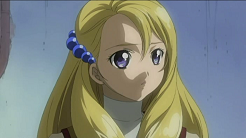
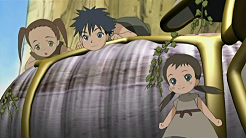
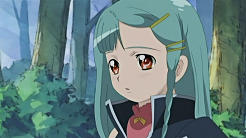
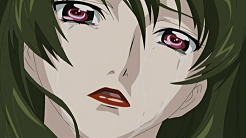
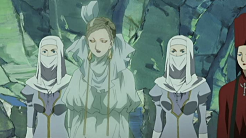

A story-driven episode for once, instead of the character-driven ones. I actually like the latter more. that’s really the department in which Simoun shines like no other. Still, that doesn’t mean that this episode wasn’t good. ^^
The most important part of the episode definitely is Onashia explaining the Emerald Ri Maajon. It’s used to travel from one time to another. We also see Dominüra and Limone back. This also gives us suspicions that Amuria is still alive as well, though in yet another time. I’m not sure whether Limone and Dominüra have landed in the future, or in the past. I personally think that they ended up in the past, as the village is filled with ancient Simoun. Still, they’re all overgrown with vines.
In any case, there was a civilization in the past which was much more advanced than the current ones. It’s interesting that Onashia speaks of “civilization” as singular, instead of plural. It’s said that the Simoun came from those days. In the end, countless wars eradicated the civilization, along with the true purpose of the Simoun. At one time, the Simoun just became useless.
Then, from the sky, it seems that a Simoun from another world, or time in this case. It was being driven by children, sent from god. These girls introduced themselves as Simoun Sibylla. Then, they informed everyone of the Emerald Ri Maajon. The Chor Dextra, which was led by Aaeru’s grandfather, by the way, was created just for the completion of the Emerald Ri Maajon. Dominüra is the only living member of it.
Dominüra also reveals something interesting in her thoughts: the reason she freaked out so horribly in episode 14, when seeing the Simoun. Well, it seems that she was one of these children, sent from god, who originally came from the other world. It seems that she forgot this, and seeing the dismantled Simoun forced her to remember again. This is indeed extremely sad, as she was the one who started the entire war for the control of the Simoun.
However, this brings up so many questions. How old is Dominüra anyway? If Aaeru’s grandfather used to pilot a Simoun, then it must mean that that Dominüra arrived in her Simoun quite some years ago. Still, she looks extremely young. I have a theory, though. Nothing has ever been said about what happens to those who refuse to go to the spring for their entire life, right? The fact that nobody speaks about it must mean that every single person went to the shrine, no exceptions. What if Dominüra is this exception? What if she just didn’t go to the spring, which made her body refuse to age for years and years to follow?
Dominüra also starts singing in front of the people who live in the time they arrived in. I think that that’s one of their rituals, they do every day, in order to give these people hope. I have no idea what started it, though I think that the villagers managed to convince them. They’re indeed living very peaceful. Interesting note: the Simoun appear to make a buzzing sound when they’re inactive.
I also noticed that Limone’s hair grew. This really reminded me of a strange pattern I noticed a while ago and which all anime seem to follow. Most anime don’t even know about hair growth. Half a year passes, and each character still has the same length of hair. Nothing grows. There have been a number of anime, though, which do feature characters who grow their hair. The strange thing, however, is that every single one of these anime has only one of these characters. No more. Simoun has Limone. All of the other characters seem to be spending a lot of time at the barber. The Law of Ueki has Rinko and I’ve heard that Haruhi Suzumiya also had this. It’s a pity that so little characters have this, as I like spotting the differences in character design that way. (That’s why I also like characters who like to change hairstyles)
In any case, the fact that this was a story-driven episode doesn’t mean that we didn’t have any character-development. This time, it came from Yun, Limone, Dominüra, Onashia and a bit of Aaeru and Paraietta.
Notice how Paraietta was very determined when the Chor Tempest was scolded for going out unauthorized (eheh, so what? Aaeru used to do this lots of times. :P). Also, notice how Aaeru gets uncomfortable when Neviriru suddenly gets hope of Amuria being alive? I wonder what kind of reasons she has for this. Does she think that she’ll lose an important pair, or an important friend to Amuria?
Both Limone and Dominüra have changed. Limone has told herself never to say “I dunno” anymore. That’s why she tries to find a suitable answer for each question asked to her. Dominüra, on her turn, has become extremely relaxed, cheerful and optimistic. We also see a surprisingly weak side of Onashia. For some reason, she became extremely exhausted on the journey back to the ruins. When she arrived, however, this weakness was gone. She also shredded off some strange, sparkling substance when she walked.
The most interesting one, though was Yun. She goes along with Aaeru and Neviriru in their mission to escort Onashia back to the ruins, as she wants to ask Onashia about her fallen comrades. Onashia told Yun the previous episode that she could hear Mamiina’s voice, so Yun was hoping that this would be the same for her former friends. She wonders whether their souls have been set free. Yun gets a response she doesn’t like. The one who desires to be set free his Yun herself. Not only does this suggest that her comrades have yet to be set free, but it also means that Yun has indeed been keeping all of her feelings inside of her. Onashia reveals that Yun wants to escape to a place far away. She’s been fooling herself all along.

Wait, I thought it’s just a simple, linear paradox involving Dominura–presumably the Simoun Sybilla has been around for generations and Dominura probably has long passed away before she was born. So her age at the present is not a problem…?
That could be it as well. Like I said, it’s just a theory. 😉
I also noticed that Limone’s hair grew…
It’s important to not that hair growth in anime is extremely rare. Cutting one’s own hair off can be seen pretty often as a symbolical act of self-resignation, throwing away previous identity – be it a good or bad thing for the character cutting their hair. It may symbolize an attempt start life over, return to child-like openness to the world, to regain innocence lost. A renounce of one’s own past, or an act of surrender (to system, to traditions) – means of throwing away your own identity are countless.
However, growing hair is not even a symbol. It’s usually a detail used to symbolize fundamental changes in character, which passing time brings forth: maturity, strength (direct biblical allusion), wisdom, determination : gaining an identity. Strong characters are extremely unpoplular in japanese anime. We may discuss their cultural background for eternity, but let us just all agree that we are happy to see character GROWTH – while character degeneration is easily more popular solution both in anime and IRL 😀
It’s unfortunate that strong characters are so unpopular in anime. I sortof like them. They’re especially great near weak one. 🙂
LOL yeah. That’s why alien nine was so splendid artwork: there was that central strong non-japanese character girl who saved the day, kicked ass and emphasized her firend’s weak character as a convincing human being image, not as a some fsckng eva-istic plot point.
Strong characters in japanese traditional context are nearly always deemed to be (or to become) villains – their social culture does not tolerate strong individuals. It’s very hard to find a strong and positive character, pictured as a trustworthy friend and not as a treacherous snake or a victim of “destiny”.